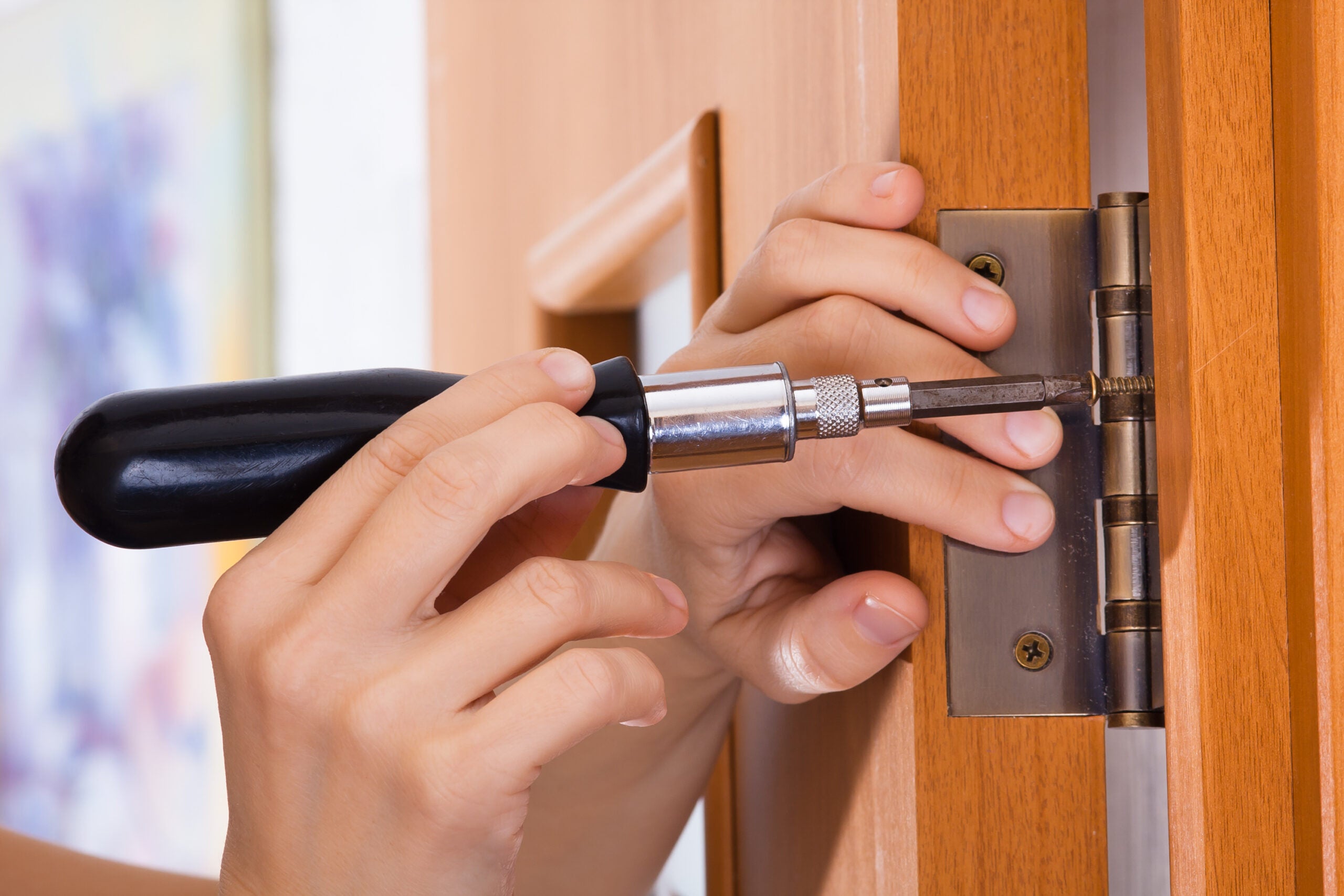Identifying the Cause of Sagging Cabinet Doors: Fix Sagging Cabinet Door

Sagging cabinet doors are a common household annoyance, often impacting both aesthetics and functionality. Understanding the root cause is crucial for effective repair. Several factors contribute to this frustrating problem, and addressing them correctly ensures a lasting solution.
Common Causes of Sagging Cabinet Doors
Sagging doors are usually the result of a combination of factors, rather than a single culprit. Over time, the weight of stored items, the natural properties of the materials used, and even the type of hinges employed all play a role. Let’s explore these in detail.
Age is a significant factor. Years of use and exposure to fluctuating humidity and temperature can cause wood to warp or expand, leading to misalignment and sagging. The weight of heavy dishes, cookware, or canned goods can also put undue stress on the door and its hinges, eventually causing the door to sag. Improper installation, such as using hinges that are not correctly aligned or secured, can also lead to sagging over time. Finally, the material itself influences sagging. Different materials react differently to environmental changes. For instance, solid wood is more resistant to warping than particleboard or MDF, which are more prone to moisture absorption and subsequent expansion or contraction.
Hinge Type and Sagging Susceptibility
The type of hinge used significantly influences a cabinet door’s longevity and resistance to sagging. Different hinges offer varying weight capacities and levels of support.
| Hinge Type | Material | Weight Capacity (approx.) | Common Issues |
|---|---|---|---|
| Full Overlay Hinge | Steel, Brass | Medium to High | Can sag if improperly installed or under excessive weight; requires precise adjustment. |
| Semi-Overlay Hinge | Steel, Zinc | Medium | More prone to sagging than full overlay hinges, especially with heavier doors. |
| Inset Hinge | Steel, Brass | Medium to High | Requires precise installation; can sag if the cabinet framing is not perfectly square. |
| European Hinge | Steel, Nickel | High | Generally durable and less prone to sagging due to robust design and precise adjustment mechanisms; however, improper installation can still cause issues. |
Material Impact on Sagging
The material used in cabinet construction directly impacts the likelihood of sagging. Solid hardwood, such as oak or maple, is the most durable and least prone to warping. However, it’s also the most expensive option. Particleboard and MDF (medium-density fiberboard) are more budget-friendly but are significantly more susceptible to moisture damage and warping, leading to increased sagging over time. Particleboard, in particular, can swell with moisture, putting extra stress on hinges and causing the door to sag. MDF is denser and more stable than particleboard but can still be affected by humidity changes.
Methods for Fixing Sagging Cabinet Doors
:max_bytes(150000):strip_icc()/how-to-adjust-cabinet-hinges-1822181-01-9518583bf0374f2a8d3b87cadd5fc25f.jpg)
Sagging cabinet doors are a common household annoyance, but thankfully, often easily fixed. This thread Artikels several methods to restore your cabinets to their former glory, from simple hinge adjustments to more involved repairs. Let’s get started!
Adjusting Existing Hinges, Fix sagging cabinet door
Often, sagging doors are simply a result of loose or improperly adjusted hinges. A quick adjustment can often solve the problem without the need for replacements. This process is generally straightforward and requires only a screwdriver.
- Assess the Sag: Carefully examine the door to determine which hinge(s) need adjustment. Note which direction the door is sagging (upward or downward). This helps you determine which screws need tightening or loosening.
- Tighten Loose Screws: Begin by tightening all screws on the affected hinges. Use a screwdriver that fits snugly to avoid stripping the screw heads. Tighten them firmly, but avoid over-tightening, which can damage the wood.
- Adjust Hinge Screws: If tightening doesn’t fully correct the sag, carefully loosen the screws slightly on the hinge(s) causing the problem. This will allow you to reposition the door. Adjust the door until it hangs evenly, then retighten the screws.
- Check Alignment: After adjusting, close the door and check its alignment. Make minor adjustments as needed to ensure the door closes smoothly and evenly with the adjacent cabinets.
Replacing Worn-Out Hinges
If adjusting the existing hinges doesn’t resolve the issue, or if the hinges themselves are damaged or worn, replacement is necessary. Choosing the right hinges is crucial for both functionality and aesthetics.
| Hinge Type | Description | Installation Method |
|---|---|---|
| Full Overlay Hinge | Completely covers the cabinet door frame when closed. | Screws directly into the door and cabinet face frame. Typically requires precise placement for proper alignment. |
| Semi-Overlay Hinge | Partially overlaps the cabinet door frame when closed. | Similar to full overlay hinges, but allows for a slightly visible frame. |
| Inset Hinge | Hinges are completely concealed within the cabinet frame. | More complex installation, often requiring specialized tools and precise measurements. |
Before replacing, measure the existing hinge’s dimensions and cup depth to ensure a proper fit with your replacement hinges. This ensures seamless integration and functionality. Once you have the correct hinges, carefully remove the old hinges and install the new ones, following the manufacturer’s instructions.
Reinforcing Weak Cabinet Frames
Sometimes, the cabinet frame itself is weak, causing the door to sag. Reinforcing the frame can provide the necessary support. This might involve using wood shims or adding support pieces.
For example, if the frame is sagging near the hinge mounting points, small wood shims can be carefully inserted between the frame and the back of the cabinet. These shims provide additional support to prevent further sagging. Secure the shims in place with appropriate screws. Alternatively, small L-shaped brackets can be added to the corners of the cabinet frame for added stability. The brackets are attached to the cabinet frame and a support piece inside the cabinet. This will provide extra support to the frame. Ensure that the added support does not interfere with the door’s functionality.
Preventative Measures and Long-Term Solutions

Preventing sagging cabinet doors is all about proactive planning and maintenance. By addressing installation, material selection, and regular care, you can significantly extend the lifespan of your cabinets and avoid costly repairs. Investing a little time upfront saves significant headaches (and money!) down the line.
Proper Installation Techniques
Correct installation is the cornerstone of preventing sagging. Improperly attached hinges, uneven weight distribution, and insufficient support all contribute to future problems. Ensure hinges are securely fastened using the appropriate screws and pilot holes. Over-tightening can cause wood to crack, while under-tightening leads to loose hinges and instability. For heavier doors, consider using more hinges than the minimum recommended, strategically placed for optimal support. Remember, a well-installed door is less likely to sag.
Weight Distribution Strategies
The weight of items stored inside cabinets directly impacts the door’s longevity. Avoid overloading cabinets with heavy items concentrated in one area. Distribute the weight evenly across the shelves. Consider using lighter materials or fewer items in cabinets prone to sagging. For example, store heavier items in lower cabinets where the structural support is typically stronger. This simple strategy dramatically reduces stress on the cabinet doors and hinges.
Regular Maintenance
Regular maintenance is key to early detection and prevention. Periodically inspect hinges for looseness and tighten as needed. Lubricate hinges with a light oil to reduce friction and wear. Check for any warping or damage to the doors themselves, addressing minor issues before they become major problems. A yearly inspection is recommended, particularly in high-humidity environments which can contribute to wood swelling and warping.
Cabinet Door Material Considerations
The material you choose for your cabinet doors significantly impacts their resistance to sagging. Each material has its own strengths and weaknesses.
Solid Wood Doors
Solid wood doors offer exceptional durability and resistance to sagging. However, they are heavier than other options, requiring robust hinges and careful weight management. The type of wood also matters; hardwoods like oak and maple are more resistant to warping than softer woods. Solid wood doors can be expensive and may require more maintenance to prevent cracking or warping due to changes in humidity.
Medium-Density Fiberboard (MDF) Doors
MDF doors are more affordable and lighter than solid wood, but are more susceptible to sagging if not properly installed or if overloaded. They are also less resistant to moisture, making them unsuitable for humid environments. MDF is a good option for lighter cabinets where weight isn’t a significant concern, but proper installation is crucial to avoid sagging.
Plywood Doors
Plywood offers a balance between cost, weight, and durability. It’s generally more resistant to sagging than MDF but not quite as strong as solid wood. The quality of the plywood (number of plies and type of wood) impacts its strength and resistance to sagging. Plywood is a good all-around choice that offers a good compromise between cost and durability.
